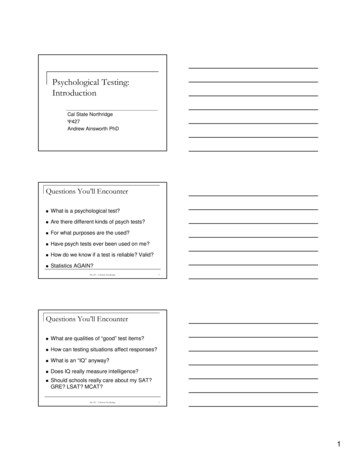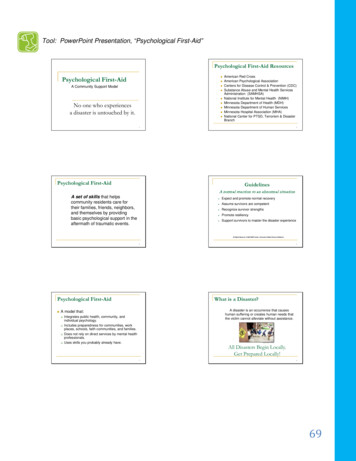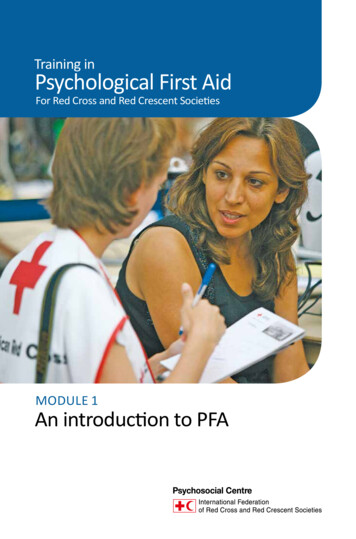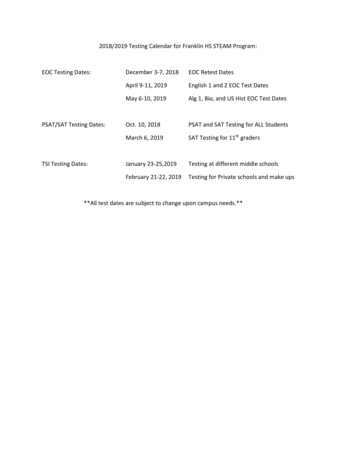
Transcription
Psychological Testing:IntroductionCal State NorthridgeΨ427Andrew Ainsworth PhDQuestions You’ll Encounter What is a psychological test? Are there different kinds of psych tests? For what purposes are the used? Have psych tests ever been used on me? How do we know if a test is reliable? Valid? Statistics AGAIN?Psy 427 - Cal State Northridge2Questions You’ll Encounter What are qualities of “good” test items? How can testing situations affect responses? What is an “IQ” anyway? Does IQ really measure intelligence? Should schools really care about my SAT?GRE? LSAT? MCAT?Psy 427 - Cal State Northridge31
Questions You’ll Encounter Can my reaction to some weird inkblot reallysay something about my personality?Can my response to a bunch of weird T/Fquestions really indicate that I have apsychopathology?All I want to do is help people, why do I needto submit them to all these torturous tests?Psy 427 - Cal State Northridge4Psychological Testing AKA Psychometrics – field of study concerned withthe theory and technique of educational andpsychological measurement (Wikipedia) measurement of knowledge, abilities, attitudes,and personality traits.It involves two major research tasks1.2.the construction of instruments and procedures formeasurementthe development and refinement of theoreticalapproaches to measurementPsy 427 - Cal State Northridge5Measurement In psychology we are interested ineither describing the distributions ofand/or relationships among abstractconcepts: e.g., Political conservatismIntelligenceNeuroticismAggressionPsy 427 - Cal State Northridge62
Measurement However, in most cases these constructs areabstractions that can often not be directly observed.Concept of IntelligenceOperationalizationMeasure or Operationalization of IntelligenceIQ testPsy 427 - Cal State Northridge7Measurement Note: that the degree to which theoperationalization of the abstract conceptactually reflects or mirrors the construct is thedegree to which the operationalization can besaid to be valid (more later).The value of scientific research is completelydependent upon the degree to which theoperationalizations are successful or valid.Psy 427 - Cal State Northridge8Concepts and Constructs Concept: “An abstraction formed by generalization fromparticulars”Abstracts are hard to defineE.g. intelligenceConstruct: A concept with scientific purpose (i.e.operationalized)Can be measured and studied.E.g. IQPsy 427 - Cal State Northridge93
Terms Review: Variables and Constants Variable: any condition, event, characteristicor attribute that can take on different valuesat different times or with different people. Age of peopleTemperatureIntelligenceXenophobiaConstant: One value in a given context.Does not change or vary.Psy 427 - Cal State Northridge10Terms Review:Independent and Dependent Variables Independent variable we are referring to a variable that theexperimenter has some direct control over andcan manipulateIn Experiments IVs are the “cause”In non-experiments IVs are the “influencei.e., X YDependent Variables The variable being influenced/predictedThe outcome variablePsy 427 - Cal State Northridge11Terms Review:Discrete & Continuous Variables Discrete variables: can only take on a finite orrestricted set of values. Continuous variables: can take an infinitenumber of values Can only take on whole values (think digital)E.g., number of children per family, Number ofstudents taking 100AE.g., Temperature (10.3 C, 10.24 C, 15.212 C),Weight (102.2lbs., 116.56 lbs.)The difference often limited only by precision124
Psych Testing Basics Test A measurement device or technique used toquantify behavior or aid in the understanding andprediction of behavior. Psychological Test a set of items designed to measure characteristicsof human beings that pertain to behavior.Behavior Overt: observable activity of the individualCovert: takes place within the individualPsy 427 - Cal State Northridge13Psych Testing Basics Scale Relate raw scores on a test to some definedtheoretical or empirical distribution.A method of operationalizing a psychologicalconstruct using a multiple item test (e.g.questionnaire)Psy 427 - Cal State Northridge14Types of Tests Individual Tests vs. Group Tests Individual tests: test administrator gives a testto a single person e.g. WAIS-III, MMPI-2Group tests: single examiner gives a test to agroup of people e.g. SAT, GREPsy 427 - Cal State Northridge155
Types of Tests (Human) Ability Tests Achievement Tests Aptitude Tests evaluates what an individual has learnedmeasures prior activityevaluates what an individual is capable of learningmeasures capacity or future potentialIntelligence Tests Measures a person’s general potential to solveproblems, adapt to novel situations and profit fromexperiencePsy 427 - Cal State Northridge16Types of Tests Personality Tests: Objective & Projective Objective Personality Tests present specific stimuli and ask for specificresponses (e.g. true/false questions) .Projective Personality Tests present more ambiguous stimuli and ask for lessspecific responses (e.g. inkblots, drawings,photographs, Rorschach, TAT)Psy 427 - Cal State Northridge17History of Psychometrics Chinese influenceIndividual Differences: Darwin and GaltonExperimental PsychologistsThe study of mental deficiencyIntelligence TestersPersonality TestersPsy 427 - Cal State Northridge186
History of Psychometrics:Chinese influence 2000 B.C.E. 206 B.C.E. to 220 C.E. Scattered evidence of civil service testing in ChinaHan Dynasty in China develops test batteries two or more tests used in conjunction.Test topics include civil law, military affairs, agriculture,revenue, geographyPsy 427 - Cal State Northridge19History of Psychometrics:Chinese influence 1368 C.E. to 1644 C.E. Ming Dynasty in China develops multistagetestingLocal tests lead to provincial capital tests; capitaltests lead to national capital testsOnly those that passed the national tests wereeligible for public office1832 English East India Company copies Chinesesystem to select employees for overseas duty.Psy 427 - Cal State Northridge20History of Psychometrics:Chinese influence 1855 British Government adopts English East IndiaCompany selection examinations.French & German governments follow shortly.1883 United States establishes the American CivilService CommissionDeveloped & administered competitiveexaminations for government service jobs.Psy 427 - Cal State Northridge217
History of Psychometrics: IndividualDifferences, Darwin and Galton Individual differences - despite oursimilarities, no two humans areexactly alike.Why?Darwinsome of these individual differences are more“adaptive” than othersthese individual differences, over time, lead tomore complex, intelligent organisms Psy 427 - Cal State Northridge22History of Psychometrics: IndividualDifferences, Darwin and Galton Galton - cousin of Darwin “Applied Darwinist”: some people possessedcharacteristics that made them “more fit”than others.Wrote Hereditary Genius (1869)Sets up an anthropometric laboratory at theInternational Exposition of 1884For 3 pence, visitors could be measuredwith: The Galton Bar - visual discrimination of lengthThe Galton Whistle (aka “dog whistle” determining highest audible pitchPsy 427 - Cal State Northridge23History of Psychometrics: IndividualDifferences, Darwin and Galton Galton’s Anthropometric LabPsy 427 - Cal State Northridge248
History of Psychometrics: IndividualDifferences, Darwin and Galton Galton Whistle (circa 1900) Galton BarPsy 427 - Cal State Northridge25Individual Differences:Darwin and Galton Galton also noted that persons with mentalretardation also tend to have diminished abilityto discriminate among heat, cold & pain.Other advances (?) of Galton’s: Considered by some the founder of psychometricspioneered rating scales & questionnairesfirst to document individuality of fingerprintsstudied efficacy of prayerfirst to apply statistics in the measurement of humansFounder of eugenicsPsy 427 - Cal State Northridge26History of Psychometrics: Galton’sFamous Students Karl Pearson Does the name Pearson sound familiar?student of Galtonextended Galton’s early work withstatistical regressionJames McKeen Cattell first to use the term “mental test”U.S. dissertation on reaction time basedupon Galton’s workPsy 427 - Cal State Northridge279
History of Psychometrics:Early Experimental Psychologists Early 19th century scientists, generallyinterested in identifying common aspects,rather than individual differences. Differences between individuals wasconsidered a source of error which renderedhuman measurement inexact.Sounds a lot like things from your past (e.g.ANOVA) and your coming futurePsy 427 - Cal State Northridge28History of Psychometrics:Early Experimental Psychologists Johan Friedrich Herbart - mathematicalmodels of the mind; founder of pedagogy asan academic discipline; went against KantErnst Heinrich Weber - sensorythresholds; just noticeable difference (JND)Gustav Theodor Fechner - mathematics ofsensory thresholds of experience; founderof psychophysics; considered of onefounders of experimental psychology;Weber-Fechner Law first to relate sensationand stimulus; considered by some thefounder of psychometricsPsy 427 - Cal State Northridge29History of Psychometrics:Early Experimental Psychologists Fechner influenced many prominentpsychologists (e.g. Wundt, Freud) Wilhelm Wundt – considered one of thefounders of psychology; first to set up apsych laboratoryEdward Titchner – succeeded Wundt;brought Structuralism to America; Hisbrain is still on display in the psychologydepartment at CornellPsy 427 - Cal State Northridge3010
History of Psychometrics:Early Experimental Psychologists Fechner influenced many prominentpsychologists (e.g. Wundt, Freud) Guy Montrose Whipple – Student ofTitchner’s; pioneer of human ability testing;conducted seminars that changed the field ofpsych testing; APA issued its first set ofstandards for professional psychologicaltesting because of his criticismsLouis Leon Thurstone – Large contributor tofactor analysis; attended Whipple’s seminars;approach to measurement was termed thelaw of comparative judgmentPsy 427 - Cal State Northridge31History of Psychometrics:Interest in Mental Deficiency 1805 – Jean-Étienne Esquirol, French Physician Favorite Student of Philippe Pinel (founder ofpsychiatry)Manuscript on “mental retardation.” Many degrees to mental retardation differentiated between insanity & mental retardationinsanity had a period of normal intellectual functioningnormality to “low-grade idiocy”Attempted to develop system to classify people intothese many degrees but found that the individual’s useof language provided the most dependable continuumPsy 427 - Cal State Northridge32History of Psychometrics:Interest in Mental Deficiency 1840s - Edouard Seguin, FrenchPhysician Pioneer in training mentally-retarded persons.Rejected the notion of incurably MR1837: opens first school devoted to teaching MRchildren.1848: emigrates to USA, wide acceptance of theories1866: experiments with physiological training of MR sense-training / muscle-training still used todayleads to nonverbal tests of intelligence (Seguin Form Board)Psy 427 - Cal State Northridge3311
History of Psychometrics:Intelligence Testing Alfred Binet 50 years after Esquirol & Seguin -- 1905French Society for the PsychologicalStudy of the Child urged Frenchministers to develop special classes forchildren who failed to respond to normalschooling.Ministers required a way to identify thechildrenPsy 427 - Cal State Northridge34History of Psychometrics:Intelligence Testing Alfred Binet First Intelligence Test: Binet-Simon Scale of 190530 items of increasing difficultyStandardized administration Same instructions & format for ALL childrenStandardization sample created norms by which performance one child can becompared with other children.Psy 427 - Cal State Northridge35History of Psychometrics:Intelligence Testing Alfred Binet Standardization Sample 50 Normal children aged 3-11yrs“Some” mentally retarded children and adults1908 Binet-Simon Scale More items (greater reliability)Better standardization sample (300 normalchildren)Introduction of Mental AgePsy 427 - Cal State Northridge3612
History of Psychometrics:Intelligence Testing Alfred Binet’s legacy 1911 Binet-Simon, minor revision Binet dies1912 Kuhlmann-Binet revisionExtends testing downward to 3 months of age1916 Lewis Madison Terman & Stanford Colleaguesrevise Binet’s test for use in the United States More psychometrically soundIntroduction of the term IQMental Age / Chronological Age IQPsy 427 - Cal State Northridge37History of Psychometrics:Intelligence Testing World War I - Robert Yerkes Need for large-scale group administered abilitytests by the armyArmy commissions Yerkes, then head of theAmerican Psychological Association, to developtwo structured tests of human abilities Army Alpha - required reading abilityArmy Beta - did not require reading abilityTesting “frenzy” hits between World War Iand the 1930s.Psy 427 - Cal State Northridge38History of Psychometrics:Intelligence Testing Testing Frenzy of the 1930’s 1937 Revision of the Stanford-Binet includes over3000 individuals in standardization1939 Wechsler-Bellevue Intelligence Scale David WechslerSubcales were “adopted” from the Army ScalesProduces several scores of intellectual ability rather thanBinet’s single scores (e.g. Verbal, Performance, FullScale)Evolves into the Wechsler Series of intelligence tests(e.g. WAIS, WISC, etc.)Psy 427 - Cal State Northridge3913
History of Psychometrics:Personality Testing Rise – 1920s, Fall – 1930s, Slow Rise –1940sIntended to measure personality traits Trait: relatively enduring dispositions (tendenciesto act, think or feel in a certain manner in anygiven circumstance)NOT temporary statesPsy 427 - Cal State Northridge40History of Psychometrics:Personality Testing First Rise and Fall: Structured TestsWoodworth Personal Data Sheet First objective personality test meant to aid inpsychiatric interviewsDeveloped during World War IDesigned to screen out soldiers unfit for dutyMistakenly assumed that a subjects responsecould be taken at face valuePsy 427 - Cal State Northridge41History of Psychometrics:Personality Testing WoodworthTest Item1. I wet the bed.Yes No2. I drink a quart of whiskey each day.3. I am afraid of closed spaces.4. I believe I am being followed.5. People are out to get me.6. Sometimes I see or hear things that otherpeople do not hear or see.Psy 427 - Cal State Northridge4214
History of Psychometrics:Personality Testing Slow Rise: Projective TestsHerman Rorschach inkblot test (1921) Started with great suspicion; first serious study in1932.Symmetric colored & b/w inkblots.Psy 427 - Cal State Northridge43History of Psychometrics:Personality Testing Rorschach inkblot examplePsy 427 - Cal State Northridge44History of Psychometrics:Personality Testing Thematic Apperception Test Henry Murray and Christina Morgan (1935)“Ambiguous” pictures though considerablymore structured than the RorschachSubjects are shown the pictures and askedto write a story including: what has led up to the event shownwhat is happening at the momentwhat the characters are feeling and thinking, andwhat the outcome of the story was.Psy 427 - Cal State Northridge4515
History of Psychometrics:Personality Testing Thematic Apperception Test ExamplePsy 427 - Cal State Northridge46History of Psychometrics:Personality Testing Second coming of the Structured TestEarly 1940s – Structured Tests were beingdeveloped based on better psychometricproperties.Minnesota Multiphasic Personality Inventory(MMPI; 1943) Tests like the Woodworth made too many assumptionsThe meaning of the test response could only bedetermined by empirical researchMost widely used (MMPI-2, MMPI-A)Psy 427 - Cal State Northridge47History of Psychometrics:Personality Testing Sixteen Personality FactorQuestionnaire Raymond B. Cattell (early 1940s)Based on Factor Analysis – method forfinding the minimum number ofdimensions (factors) for explaining thelargest number of variablesPsy 427 - Cal State Northridge4816
History of Psychometrics: Intelligence Testing Alfred Binet Standardization Sample 50 Normal children aged 3-11yrs “Some” mentally retarded children and adults 1908 Binet-Simon Scale More items (greater reliability) Better standardization sample (300 normal children) Introductio











